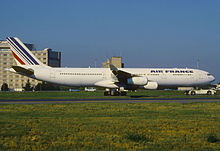Air France Flight 358

F-GLZQ, the aircraft involved in the incident, at Charles de Gaulle Airport.
|
|
| Accident summary | |
|---|---|
| Date | August 2, 2005 |
| Summary | Weather-induced runway overrun, lack of company procedures related to distance calibration for approaches and landings during thunderstorms, pilot error |
| Site |
Toronto Pearson International Airport Mississauga, Ontario, Canada 43°39′23.2″N 79°37′29.0″W / 43.656444°N 79.624722°WCoordinates: 43°39′23.2″N 79°37′29.0″W / 43.656444°N 79.624722°W |
| Passengers | 297 |
| Crew | 12 |
| Fatalities | 0 |
| Injuries (non-fatal) | 43 (42 minor, 1 serious) |
| Survivors | 309 (all) |
| Aircraft type | Airbus A340-313E |
| Operator | Air France |
| Registration | F-GLZQ |
| Flight origin |
Charles de Gaulle Airport Paris, France |
| Destination |
Toronto Pearson International Airport Mississauga, Ontario, Canada |
|
|
Air France Flight 358 was an Airbus A340-313E, registration F-GLZQ, on a scheduled international flight from Paris, France, to Toronto, Ontario, Canada. On August 2, 2005, while landing at Toronto Pearson International Airport at 4:01 p.m. EDT, it crashed into nearby Etobicoke Creek, approximately 300 m (980 ft) beyond the end of the runway. All 309 passengers and crew aboard the Airbus A340 survived, with 12 people sustaining serious injuries. The accident highlighted the role played by highly trained flight attendants during an emergency.
Due to inclement weather, 540 flights departing and arriving at Pearson were cancelled. Many small and mid-size aircraft due to arrive were diverted to other Canadian airports in Ottawa, London, Hamilton, and Winnipeg. Most of the larger aircraft were diverted to Montreal,Syracuse, New York, and Buffalo, New York. Flights from Vancouver were turned back. The crash of Air France Flight 358 was the biggest crisis to hit Toronto Pearson since the airport's involvement in Operation Yellow Ribbon.
Jean Lapierre, the Canadian Minister of Transport, referred to Flight 358 as a "miracle" because all of the passengers survived. Other press sources described the accident as the "Miracle in Toronto", the "Toronto Miracle", the "Miracle" Escape, and the Miracle of Runway 24L".
The accident was investigated by the Transportation Safety Board of Canada (TSB), with a final report issued on December 13, 2007.
The aircraft operating Flight 358 was a 295-seat Airbus A340-313E powered by four CFM International CFM56 engines. With manufacturer's serial number 289 and registration F-GLZQ, it was first flown on August 3, 1999, and delivered to Air France on September 7, 1999. There were 297 passengers and 12 crew aboard the Airbus. On this flight, it was flown by Captain Alain Rosaye, 57, and First Officer Frédéric Naud, 43. Rosaye was a seasoned pilot with 15,411 total flight hours and Naud had 4,834 hours of flight time.
...
Wikipedia
